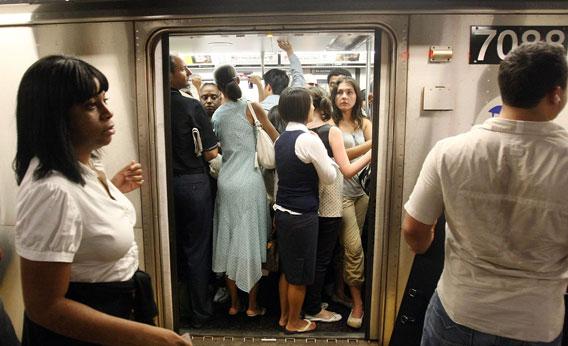Mass transit has, according to its fans, a staggering array of benefits. It reduces pollution, improves quality of life, and anchors vibrant walkable communities. It boosts public health and makes people happier. But relatively few transit-boosters understand that existing federal guidelines for assessing which new projects to fund not only exclude those considerations, they make it extremely difficult for newly built transit to meet those objectives. A new proposed rule from the Department of Transportation, now entering its 60-day comment period to let people raise objections, should change all that for the better.
The existing rule, sadly, evaluates proposals almost exclusively on the basis of how much time a new rail line shaves off commutes. But taking a train station-to-station rather than driving a car door-to-door is guaranteed to be slower unless traffic jams are severe. This has biased new mass-transit construction in favor of a very particular kind of project: First identify a highway that’s already extremely congested and where widening it is either politically or logistically impossible. Then build commuter-rail tracks in the highway median. Put the stations far apart from one another so that trains can cruise at maximum speed for a long time. Surround the stations with parking lots. Driving your car to a park-and-ride station and taking the train downtown is now cheaper and perhaps faster than the average trip on the congested highway.
That’s how you get something like the Washington, D.C. Metro’s Orange Line in Fairfax County, Va. Trains run in the I-66 median, and stations are far apart and surrounded by open-air parking lots. It’s a helpful addition to the region’s commuter mix. But it doesn’t create the kind of transit-oriented neighborhoods that you see all over Brooklyn or Boston.
For that, you need something else entirely. You need train stations surrounded by densely built structures, not parking lots. And you need the stations to be relatively close to each other. Dense building around one station creates a little circle of walkability. A series of stations built close together, each surrounded by its own little circle, creates a string of walkable pearls that re-enforce each other. That’s how you get whole new communities where people get by with fewer than one car per adult, spurring a circle of demand for pedestrian-oriented businesses and decreased demand for car ownership. And that’s what gives you big public health and environmental benefits.
You can see this at work on a different stretch of the Orange Line, where Arlington County put up the money to run it beneath Wilson Boulevard and Fairfax Drive rather than in the highway median. The stations—Rosslyn, Courthouse, Clarendon, Virginia Square, and Ballston—are close together. The result is a dense corridor representing an innovative 21st-century form of urbanism. It lacks some of the charm of older neighborhoods, but it works well and combines most of their functional benefits with modern amenities.
Such projects are rare, however, because walkable urbanism can’t promise fast commutes. My daily 30-minute walk from my apartment in downtown D.C. to Slate’s office in Dupont Circle, for example, is a bit longer than the national average. But it’s free, ecologically sound, and guarantees that I get some exercise on a daily basis.
DOT’s proposed new approach will improve on the old one by putting cost-benefit analysis in a much clearer framework. The cost will still be the cost (“annualized capital cost and operating cost,” as the cool kids put it) but the main benefit will now be that people ride the thing. So a project with a high ratio of benefits to costs will be one that operates efficiently and attracts a large number of riders relative to the price of construction. This is the common-sense way to do it. Local subway trains through Manhattan are not a particularly fast way to move, but we know they’re valuable because they’re full of people. Judging benefits primarily in terms of ridership aligns the incentives with the most important goals of a transit system: creating dense, high-value neighborhoods near the stations that facilitate the benefits of urban living and reduce the need for suburbs to sprawl endlessly away from the city center.
Less appealing is DOT’s proposal to separately consider social-inclusion benefits such as affordable housing. When you look at the nation or a given metropolitan area as a whole, the important driver of how affordable houses are is the overall supply. The idea of measuring benefits in terms of ridership already captures the idea that housing should be plentiful. Favoring a project that involves less housing on the grounds that a larger share of the smaller quantity is “affordable” is only going to reduce the overall quantity of people who can afford transit-adjacent housing.
At the end of the day, that’s more a quibble than a criticism. But I don’t like to see the pristine simplicity and splendor of the new rule brought down with unnecessary and possibly counterproductive twist. Transit projects should be built where it’s cheapest to serve the most riders. This principle can and should stand on its own.
